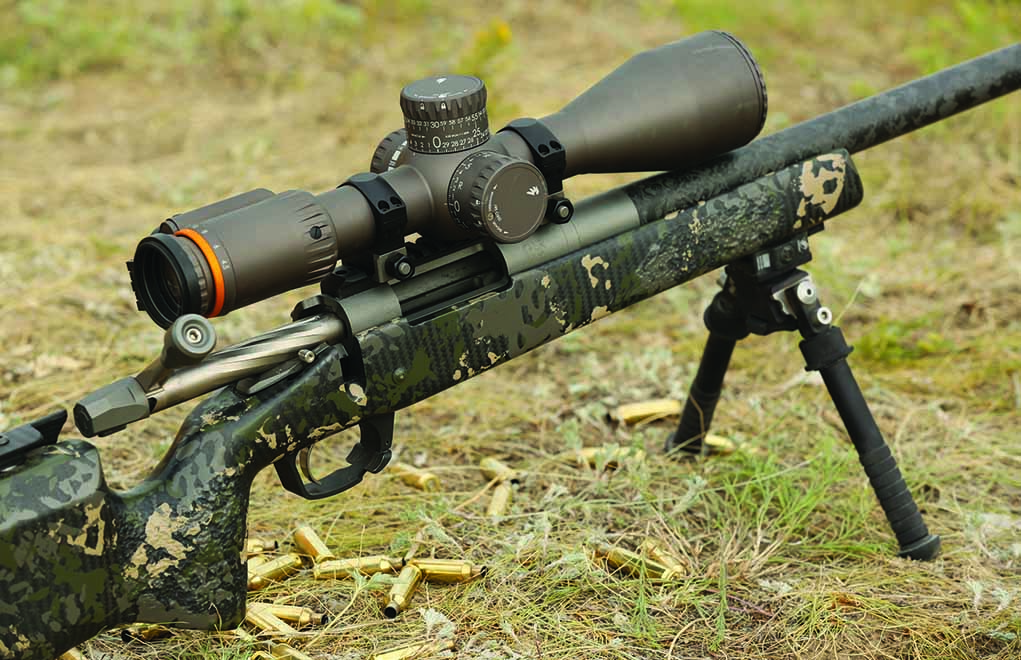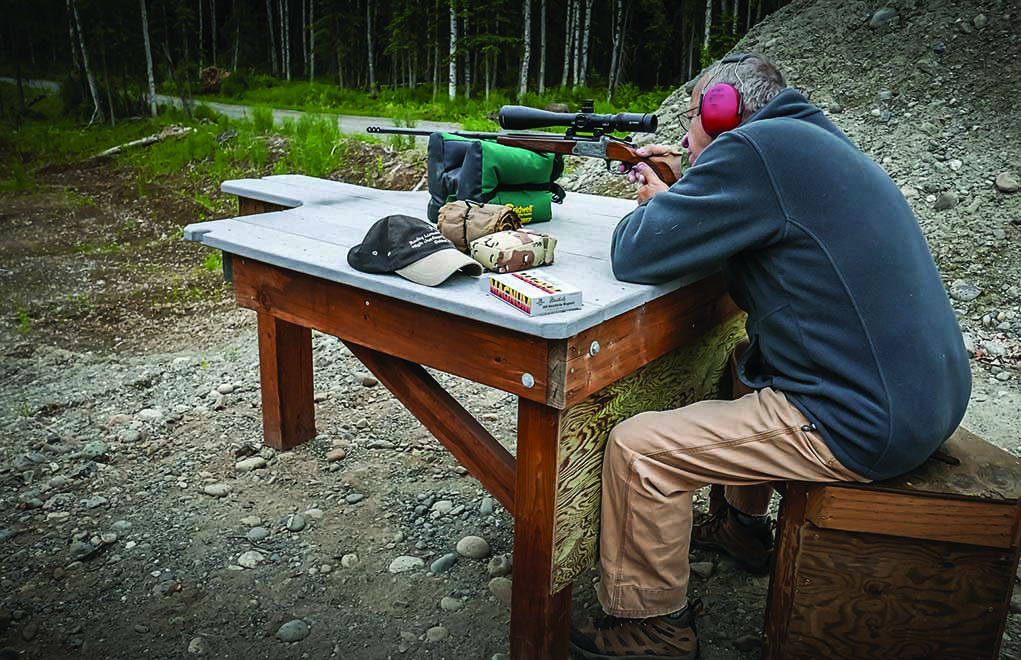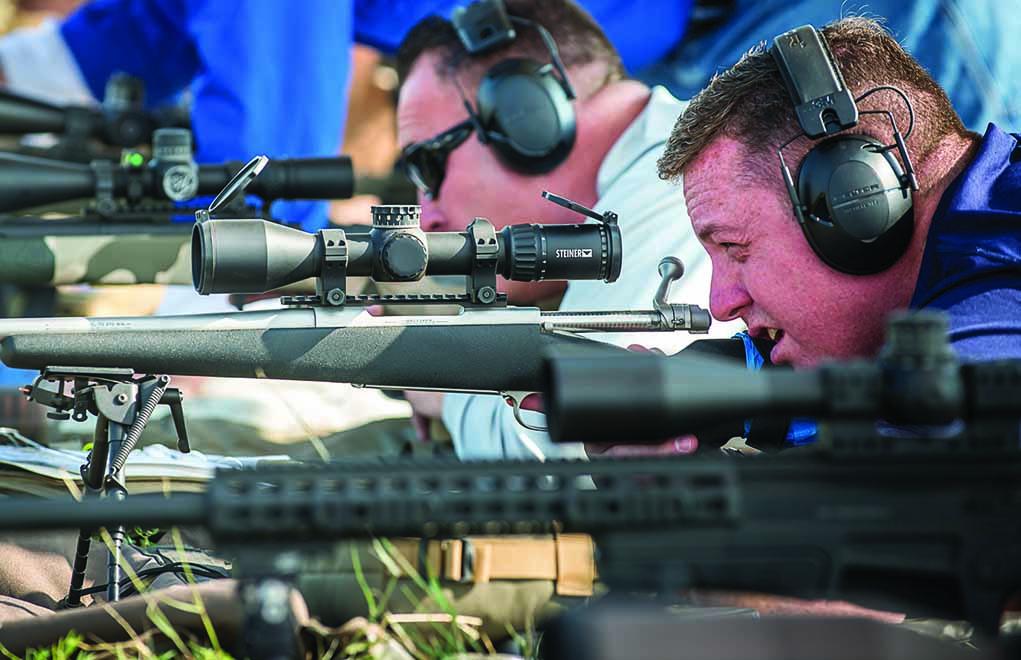
Extending your hunting range is all about “WTF”: wind, trajectory and the fundamentals of marksmanship.
How to accurately extend your hunting range:
- Consider a carbon-fiber wrapped barrel or crossover rifle.
- Use air-filled support bags for rests.
- Invest in an optic with target turrets.
- Learn to use BDC reticles.
- Understand offsets.
- Shoot hunting ammo that mirrors match ammo performance.
- Above all TRAIN!
Hunters often get a terrible rap in the marksmanship department, and on behalf of the precision rifle shooting community as a whole — we’re looking to change that. The Sniper’s Hide precision rifle marksmanship classes never really appealed to the hunters out there until recently … when we started teaching in Alaska.

Alaska is called “The Last Frontier” for a reason. When we first arrived on the scene 4 years ago, very few instructors would travel that far north. By partnering with my former Platoon Sargent, Marc Taylor, we’ve opened up a brand-new avenue for the hunter to increase their max effective range on targets — using their standard hunting rifles. Taking the Marine Corps Marksmanship principles, and applying them to our students who are focused on hunting, has been deeply rewarding for me on a personal level.
Hunters face a different set of challenges than does the average PRS shooter: Their rifles are not meant to be shot like a target rifle, their optics are limited in the amount of travel and their bullets are not match-grade quality. This is all changing, and keeping abreast of modern advances can help the “traditional” hunter evolve their skillset as well.
The Rifle
Hunting rifles have come a very long way: Their accuracy has improved as technology changes. While many of them still host very thin and light barrels, once you recognize the limitations you can adapt your training to work within those limitations.
More Long-Range Shooting Info:
- Buying the Perfect Precision Scope
- Ballistics Basics: Initial Bullet Speed
- The Effects Of Air Temperature On Bullet Flight
- Mils vs. MOA: Which Is The Best Long-Range Language?
During class, we manage the shots: Never shoot more than five shots in any given series. Heat is not our friend, and the more rounds you force down the barrel the worse things get for a hunting rifle. Here, it’s all about quality — not quantity. Focus on the fundamentals and take each shot individually.
We understand that “light is right” when it comes to movement and stalking, so we’re not trying to change how a hunter does business from that perspective, but we often recommend the new carbon-fiber options out there to help cross over between hunting and target. It’s very possible to keep the rifle under 10 pounds while, at the same time, affording the ability to practice and train without the negative consequences of a pencil-thin barrel.

Barrels from companies such as Proof Research have changed the game. Combined with carbon-fiber stocks, a hunter can easily drop the weight of a rifle and maintain precision and accuracy across far more shots downrange. Proof Research barrels are proven winners: I run three and have never been let down yet.
Also, crossover rifles are becoming increasingly popular. Gunwerks is doing outstanding work in this field by offering rifles that can be used for both competition and hunting — a concept that was unheard of just a few years ago. Nobody hunting an Alaskan Sheep wants to lug around a 15-pound tactical rifle in that type of terrain, but they will use a very similar one that tops out at 8 pounds. When considering a new hunting rifle, look at these carbon-fiber options regardless of your style of hunting.
Speaking of weight, we at Sniper’s Hide also use a host of rear and support bags that are air-filled and weigh next to nothing. These bags support the rifle and shooter very well, and they add very little to your overall load.
The Optics
Optics companies have recognized the need to increase the elevation capabilities of their hunting scopes, and that bodes very well for hunters looking to expand the reach of their hunting rifles. Optics such as the Swarovski X5 and the Nightforce SHV have bridged the gap. It’s all about target turrets and elevation.
Why hold when you can dial? Why zero at 200 or 300 yards when you can zero at 100 and dial-up to your point-blank range value? You have far more flexibility when you understand your optics, and the shooter can dial a point-of-aim that matches the point-of-impact. You can still hold the minor adjustments because the reticles have actual values of calculation as well, just like tactical riflescopes — it allows you to shoot and dope your rifle to distance.

I highly recommend a crossover optic with target turrets versus one with a single-turn, capped elevation turret. That said, BDC reticles can work if you understand how to correctly zero and use them. Use a gross zero at short ranges, and then fine-tune that zero at the midpoint of the reticle hold. Also, fine-tune the zero in the middle of the adjustment range.
Lastly, it’s important to understand the offsets. Learn how to adjust the turret elevation to account for changes in conditions when traveling. If you zeroed your BDC reticle at sea level and then traveled to 5,000 feet above sea level to score that trophy elk, it’s important to know how to dial the adjustment to the BDC value for the elevation changes using the turret. Atmospheric changes matter, and moving up and down in altitude is a climatic change that requires a scope adjustment.
Competence Breeds Confidence
Training creates competence with your equipment, and that competence breeds confidence in your shooting. Having just finished up a precision rifle class in Colorado, I want to relate the story of James.
James came to my precision rifle class with a hunting rifle chambered in .270 Win. We recognized that, although his hunting rifle was equipped with a thin barrel, it also had a Steiner tactical riflescope — so he was not limited by his scope’s adjustment range. James could keep pace with the distances shot without having to compromise; we just limited the number of rounds he shot as compared to the rest of the class.
James was a rock star on the line. He absorbed the fundamentals of marksmanship, and the result was first-round hits out to distance on sub-MOA targets. James not only scored first-round hits, but he consistently went three for three on targets, including one at a distance of 1,000 yards. Did I mention the wind averaged 12-16 mph all weekend? They had a minor effect on James’ accuracy.

Using Hornady Precision Hunter Ammunition helps a lot, too. In my opinion, this ammunition is as close to match-grade as you can get. We see solid results with this over many other factory rounds available.
Invest In Training, Not Just Gear
Many hunters need to get out of the old-school mindset and take a more modern approach to hunter training and equipment. The costs associated with hunting can be significant: The travel expenses, the time away from work and family — it makes sense to invest in your success through training. It can be the difference between a successful trip and the one that got away.
The fundamentals of marksmanship apply to all disciplines of shooting. While some disciplines host unique challenges for the shooter, I have yet to find a problem that a healthy application of the fundamentals cannot solve.
It’s all about “WTF”: wind, trajectory and the fundamentals of marksmanship.
Editor's Note: This article originally appeared in the October 2018 issue of Gun Digest the Magazine.

Next Step: Get your FREE Printable Target Pack
Enhance your shooting precision with our 62 MOA Targets, perfect for rifles and handguns. Crafted in collaboration with Storm Tactical for accuracy and versatility.
Subscribe to the Gun Digest email newsletter and get your downloadable target pack sent straight to your inbox. Stay updated with the latest firearms info in the industry.

![Best Concealed Carry Guns In 2025 [Field Tested] Wilson Combat EDC X9S 1](https://gundigest.com/wp-content/uploads/Wilson-Combat-EDC-X9S-1-324x160.jpg)


![Best 9mm Carbine: Affordable PCCs [Tested] Ruger Carbine Shooting](https://gundigest.com/wp-content/uploads/Ruger-Carbine-Shooting-100x70.jpg)
![Best AR-15: Top Options Available Today [Field Tested] Harrington and Richardson PSA XM177E2 feature](https://gundigest.com/wp-content/uploads/Harrington-and-Richardson-PSA-XM177E2-feature-100x70.jpg)
